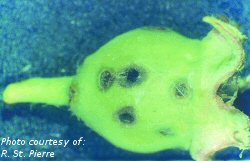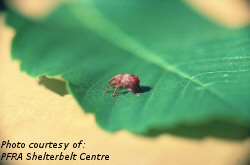Apple Curculio (Anthonomus Quadrigibbus)

Feeding punctures from apple curculio

Apple curculio larvae and pupae on sweet cherry

Apple curculio larvae in Saskatoon

Apple curculio adult
Host Plants And Distribution
Chokecherry, saskatoon, apple, crabapple, hawthorn and pear are hosts for the apple curculio. This insect is known from Manitoba, Saskatchewan, British Columbia and Ontario. It is likely found in Alberta and the northern United States as well.
Biology
The apple curculio overwinters as an adult in leaf litter near the host plant. The adults emerge in the spring at the same time as saskatoons begin to flower. Adults are 5 mm long, reddish-brown in colour, with a distinct curved snout. Adult curculios feed on immature fruit and shoot tips, resulting in puncture marks. Egg laying occurs near the end of the period of fruit drop, roughly one month after peak flowering. A single egg is laid in a puncture at the base of the young fruit near the stem. Small, whitish larvae with brown heads initially feed on a single developing seed within the fruit. Once that seed is destroyed, the larvae will move to another seed, and by the time larval development is complete, all seed within the fruit will be eaten. Larval development and pupation occur in fruit that remain on the plant. Larval development requires about four weeks and pupation requires one week. New adults emerge from mid-July to mid-August. New adults do not feed on the ripe fruit and enter the leaf litter soon after emergence from the damaged fruit. There is only one generation per year. A second similar weevil, the hawthorn weevil, is also present at the same time and should also be considered a pest.
Symptoms And Damage
Feeding and egg laying by adults create small, dark puncture wounds on green fruit and young shoot tips. Larvae destroy seeds within the fruit and infested fruit do not drop off the plant as uninfested fruit do.
Damage to saskatoon can be extensive. Adult feeding causes fruit to be of poor quality. Fruit with larvae and puncture marks are undesirable to pickers.
Scouting Techniques
Plants should be inspected shortly before and during fruit set for the presence of adult curculios. A sweep net may be used to collect adults from saskatoon and chokecherry, as the beetles may be difficult to see on the plant. Fruit may be inspected for presence of punctures caused by egg laying.
Economic Thresholds
No economic thresholds have been developed for this insect. Removal of affected green fruit is extremely time-consuming, but may reduce populations in subsequent years. These insects survive better in poorly cultivated orchards. Effective weed management may aid in keeping populations down.

